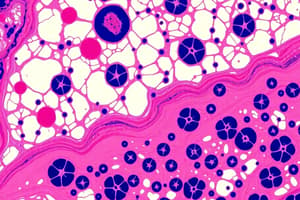Podcast
Questions and Answers
Which of the following best describes the primary distinction between the use of formalin and glutaraldehyde in tissue fixation?
Which of the following best describes the primary distinction between the use of formalin and glutaraldehyde in tissue fixation?
- Formalin uniquely prevents autolysis by rapidly denaturing enzymes, unlike glutaraldehyde which requires additional enzymatic inhibitors.
- Formalin is preferred for electron microscopy due to its superior ultrastructural preservation capabilities, while glutaraldehyde is better suited for routine histological analysis.
- Glutaraldehyde provides superior ultrastructural preservation necessary for electron microscopy, while formalin is favored for routine histology due to its ability to cross-link proteins effectively and preserve tissue architecture. (correct)
- Glutaraldehyde excels in preserving the overall tissue architecture by effectively cross-linking proteins, whereas formalin is specifically used for preserving lipids.
During tissue processing, clearing agents are utilized to remove the dehydrating agent from the tissue. If clearing is insufficient, which of the following downstream effects is most likely?
During tissue processing, clearing agents are utilized to remove the dehydrating agent from the tissue. If clearing is insufficient, which of the following downstream effects is most likely?
- Incomplete clearing will prevent proper paraffin infiltration, leading to a brittle tissue block prone to fracturing during sectioning. (correct)
- Incomplete clearing will lead to uneven section thickness, causing alternating thick and thin areas in the final stained slide.
- Inadequate clearing will result in excessive tissue shrinkage due to prolonged exposure to ethanol.
- Insufficient clearing will cause over-staining of the tissue, obscuring cellular details during microscopic examination.
A researcher is examining a tissue sample under a microscope but observes significant diffraction artifacts that obscure cellular details. Which microscopy technique would best minimize these artifacts and enhance image clarity?
A researcher is examining a tissue sample under a microscope but observes significant diffraction artifacts that obscure cellular details. Which microscopy technique would best minimize these artifacts and enhance image clarity?
- Fluorescence microscopy using a shorter excitation wavelength to reduce diffraction.
- Bright-field microscopy with increased light intensity, to overcome the diffraction effects.
- Phase-contrast microscopy, because it amplifies variations in the refractive index within the sample.
- Electron microscopy, because it uses electrons with much shorter wavelengths than light, significantly reducing diffraction. (correct)
A tissue sample from the lung shows damage to the extracellular matrix with compromised structural integrity. Which type of fiber is most likely affected?
A tissue sample from the lung shows damage to the extracellular matrix with compromised structural integrity. Which type of fiber is most likely affected?
Which of the following scenarios would necessitate the use of immunohistochemistry over standard H&E staining?
Which of the following scenarios would necessitate the use of immunohistochemistry over standard H&E staining?
In a study comparing the efficacy of different fixatives on preserving enzyme activity within tissues, which fixative would be least suitable?
In a study comparing the efficacy of different fixatives on preserving enzyme activity within tissues, which fixative would be least suitable?
During the embedding process, a technician notices that the paraffin wax is not fully infiltrating a dense connective tissue sample. What modification to the standard protocol would most likely improve paraffin infiltration?
During the embedding process, a technician notices that the paraffin wax is not fully infiltrating a dense connective tissue sample. What modification to the standard protocol would most likely improve paraffin infiltration?
A researcher is investigating the effects of a novel drug on epithelial cell tight junctions. Which microscopy technique would provide the most detailed visualization of these structures?
A researcher is investigating the effects of a novel drug on epithelial cell tight junctions. Which microscopy technique would provide the most detailed visualization of these structures?
You are examining a histological slide of the trachea and observe a single layer of cells that appear to be of varying heights, with nuclei at different levels. What is the primary function of this specific epithelial type?
You are examining a histological slide of the trachea and observe a single layer of cells that appear to be of varying heights, with nuclei at different levels. What is the primary function of this specific epithelial type?
Which of the following best explains why skeletal muscle appears striated under a microscope?
Which of the following best explains why skeletal muscle appears striated under a microscope?
What is the most critical function of glial cells within nervous tissue that directly contributes to the efficient transmission of electrical signals by neurons?
What is the most critical function of glial cells within nervous tissue that directly contributes to the efficient transmission of electrical signals by neurons?
Which of the following characteristics differentiates endocrine glands from exocrine glands at a histological level?
Which of the following characteristics differentiates endocrine glands from exocrine glands at a histological level?
During a histopathological examination of a skin biopsy, the pathologist observes an abnormal increase in the number of melanocytes within the epidermis, along with irregular pigmentation. Which of the following conditions is most likely?
During a histopathological examination of a skin biopsy, the pathologist observes an abnormal increase in the number of melanocytes within the epidermis, along with irregular pigmentation. Which of the following conditions is most likely?
Following a myocardial infarction (heart attack), histological analysis of the affected area would most likely reveal which of the following changes in cardiac muscle tissue?
Following a myocardial infarction (heart attack), histological analysis of the affected area would most likely reveal which of the following changes in cardiac muscle tissue?
A researcher aims to quantify the amount of collagen in liver biopsies from patients with cirrhosis. Which specific staining technique, when combined with image analysis software, would be most appropriate for this purpose?
A researcher aims to quantify the amount of collagen in liver biopsies from patients with cirrhosis. Which specific staining technique, when combined with image analysis software, would be most appropriate for this purpose?
In a tissue sample from a patient with an autoimmune disease, you observe an increased presence of plasma cells. What is the primary function of these cells that relates to the patient's condition?
In a tissue sample from a patient with an autoimmune disease, you observe an increased presence of plasma cells. What is the primary function of these cells that relates to the patient's condition?
Which of the following changes observed in a biopsy of the small intestine would be most indicative of celiac disease?
Which of the following changes observed in a biopsy of the small intestine would be most indicative of celiac disease?
You are examining a lymph node biopsy from a patient suspected of having lymphoma. Which histological finding would be most concerning for malignancy?
You are examining a lymph node biopsy from a patient suspected of having lymphoma. Which histological finding would be most concerning for malignancy?
Which of the following microscopes is most appropriate for visualizing the surface of a kidney stone to determine its crystalline structure?
Which of the following microscopes is most appropriate for visualizing the surface of a kidney stone to determine its crystalline structure?
While examining a stained section of lung tissue, you note the presence of foreign particulate matter within macrophages. Which of the following best describes how the macrophages are likely visualized, assuming the tissue was stained with H&E?
While examining a stained section of lung tissue, you note the presence of foreign particulate matter within macrophages. Which of the following best describes how the macrophages are likely visualized, assuming the tissue was stained with H&E?
Flashcards
Histology
Histology
The study of the microscopic structure of tissues, bridging molecular biology, cell biology, and physiology.
Fixation
Fixation
Preserves tissue structure and prevents self-digestion (autolysis).
Formalin (Formaldehyde)
Formalin (Formaldehyde)
A common fixative that cross-links proteins to preserve overall tissue architecture.
Tissue Processing
Tissue Processing
Signup and view all the flashcards
Dehydration (Tissue)
Dehydration (Tissue)
Signup and view all the flashcards
Clearing (Tissue)
Clearing (Tissue)
Signup and view all the flashcards
Infiltration (Tissue)
Infiltration (Tissue)
Signup and view all the flashcards
Embedding (Tissue)
Embedding (Tissue)
Signup and view all the flashcards
Sectioning (Tissue)
Sectioning (Tissue)
Signup and view all the flashcards
Staining (Tissue)
Staining (Tissue)
Signup and view all the flashcards
Hematoxylin and Eosin (H&E)
Hematoxylin and Eosin (H&E)
Signup and view all the flashcards
Immunohistochemistry
Immunohistochemistry
Signup and view all the flashcards
Light Microscopy
Light Microscopy
Signup and view all the flashcards
Electron Microscopy
Electron Microscopy
Signup and view all the flashcards
Epithelial Tissue
Epithelial Tissue
Signup and view all the flashcards
Connective Tissue
Connective Tissue
Signup and view all the flashcards
Muscle Tissue
Muscle Tissue
Signup and view all the flashcards
Nervous Tissue
Nervous Tissue
Signup and view all the flashcards
Glands
Glands
Signup and view all the flashcards
Pathological Histology (Histopathology)
Pathological Histology (Histopathology)
Signup and view all the flashcards
Study Notes
- Histology is the study of the microscopic structure of tissues.
- It bridges the gap between molecular biology, cell biology, and physiology.
- Histological analysis is essential for understanding tissue organization, function, and pathology.
Tissue Preparation
- Tissue preparation is crucial for accurate histological analysis.
- The main steps include fixation, processing, embedding, sectioning, and staining.
Fixation
- Fixation aims to preserve tissue structure and prevent autolysis (self-digestion).
- Common fixatives include formaldehyde (formalin) and glutaraldehyde.
- Formalin cross-links proteins, preserving overall tissue architecture.
- Glutaraldehyde provides better ultrastructural preservation for electron microscopy.
- Fixation stabilizes the tissue, preventing degradation.
Processing
- Tissue processing involves dehydration, clearing, and infiltration.
- Dehydration removes water from the tissue using increasing concentrations of ethanol.
- Clearing replaces the ethanol with a solvent miscible with both ethanol and paraffin wax, such as xylene.
- Infiltration replaces the clearing agent with a support medium, usually molten paraffin wax.
- Processing prepares the tissue for embedding.
Embedding
- Embedding involves encasing the tissue in a solid medium, usually paraffin wax.
- The embedded tissue provides support during sectioning.
- The tissue is placed in a mold, and molten paraffin wax is poured around it.
- After cooling and solidifying, the paraffin block is ready for sectioning.
Sectioning
- Sectioning involves cutting the paraffin block into thin slices using a microtome.
- Microtomes use a sharp blade to cut sections typically 5-10 micrometers thick.
- The thin sections are then floated on a water bath to remove wrinkles.
Staining
- Staining enhances contrast and allows visualization of tissue components.
- Hematoxylin and eosin (H&E) staining is the most common histological stain.
- Hematoxylin stains acidic structures (e.g., DNA, RNA) blue or purple.
- Eosin stains basic structures (e.g., proteins) pink or red.
- Other stains, such as trichrome stains, periodic acid-Schiff (PAS), and silver stains, are used for specific tissue components.
- Immunohistochemistry uses antibodies to detect specific proteins.
Microscopy
- Microscopy is used to view stained tissue sections.
- Light microscopy uses visible light to magnify the image.
- Electron microscopy uses electrons to achieve higher magnification and resolution.
Light Microscopy
- Bright-field microscopy is the most common type of light microscopy.
- The sample is illuminated from below, and the image is viewed through an objective lens and eyepiece.
- Phase-contrast microscopy enhances contrast in unstained samples by exploiting differences in refractive index.
- Fluorescence microscopy uses fluorescent dyes to label specific molecules.
Electron Microscopy
- Transmission electron microscopy (TEM) uses a beam of electrons to create an image.
- TEM provides high-resolution images of cellular ultrastructure.
- Scanning electron microscopy (SEM) scans the surface of a sample with a focused beam of electrons.
- SEM provides detailed images of the sample's surface topography.
Basic Tissue Types
- There are four basic tissue types: epithelial, connective, muscle, and nervous.
- These tissues are defined by their structure, function, and the characteristics of their cells and extracellular matrix.
Epithelial Tissue
- Epithelial tissue covers surfaces, lines cavities, and forms glands.
- Epithelial cells are tightly packed and attached to a basement membrane.
- Epithelial tissue functions in protection, absorption, secretion, and excretion.
- Types of epithelium include:
- Simple squamous epithelium: single layer of flattened cells (e.g., lining of blood vessels).
- Simple cuboidal epithelium: single layer of cube-shaped cells (e.g., kidney tubules).
- Simple columnar epithelium: single layer of column-shaped cells (e.g., lining of the stomach).
- Stratified squamous epithelium: multiple layers of flattened cells (e.g., epidermis of the skin).
- Pseudostratified columnar epithelium: single layer of cells with varying heights (e.g., trachea).
- Transitional epithelium: capable of stretching (e.g., urinary bladder).
Connective Tissue
- Connective tissue supports, connects, and separates different tissues and organs.
- Connective tissue consists of cells and an extracellular matrix composed of fibers and ground substance.
- Types of connective tissue include:
- Connective tissue proper: loose and dense connective tissue.
- Cartilage: hyaline, elastic, and fibrocartilage.
- Bone: compact and spongy bone.
- Blood: red blood cells, white blood cells, and platelets.
- Fibers in the extracellular matrix include collagen fibers (strength), elastic fibers (elasticity), and reticular fibers (support).
- Cells in connective tissue include fibroblasts, adipocytes, mast cells, and macrophages.
Muscle Tissue
- Muscle tissue is responsible for movement.
- There are three types of muscle tissue: skeletal, smooth, and cardiac.
- Skeletal muscle is striated and voluntary (e.g., biceps muscle).
- Smooth muscle is non-striated and involuntary (e.g., walls of blood vessels).
- Cardiac muscle is striated and involuntary (e.g., heart).
Nervous Tissue
- Nervous tissue is responsible for communication and control.
- Nervous tissue consists of neurons and glial cells.
- Neurons transmit electrical signals.
- Glial cells support and protect neurons.
- Nervous tissue is found in the brain, spinal cord, and nerves.
Glands
- Glands are specialized epithelial tissues that secrete substances.
- Exocrine glands secrete substances onto a surface through ducts.
- Endocrine glands secrete hormones into the bloodstream.
- Examples of exocrine glands include sweat glands, salivary glands, and digestive glands.
- Examples of endocrine glands include the thyroid gland, adrenal gland, and pituitary gland.
Specialized Tissues and Organs
- Histology is essential for understanding the structure and function of specialized tissues and organs.
- Examples include:
- Skin: epidermis, dermis, and hypodermis.
- Respiratory system: trachea, bronchi, and alveoli.
- Digestive system: esophagus, stomach, small intestine, and large intestine.
- Cardiovascular system: heart and blood vessels.
- Urinary system: kidneys, ureters, bladder, and urethra.
- Nervous system: brain, spinal cord, and nerves.
- Endocrine system: glands that secrete hormones.
- Reproductive system: male and female reproductive organs.
- Lymphatic system: lymphatic vessels and lymphoid organs.
Pathological Histology
- Pathological histology, also known as histopathology, involves the microscopic examination of abnormal tissues.
- It is used to diagnose diseases, evaluate the extent of disease, and monitor the response to treatment.
- Biopsies and surgical specimens are commonly examined in histopathology.
- Pathologists analyze tissue sections to identify abnormalities in cell structure, tissue organization, and the presence of pathogens.
- Histopathology is essential for the diagnosis of cancer, infectious diseases, and other conditions.
Studying That Suits You
Use AI to generate personalized quizzes and flashcards to suit your learning preferences.




